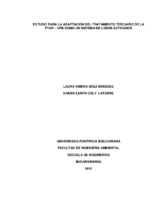Estudio para la adaptación del tratamiento terciario de la PTAR - UPB como un sistema de lodos activados

View/
Date
2014-03xmlui.dri2xhtml.METS-1.0.item-advisor
Cajigas Cerón, Álvaro Andrés
xmlui.dri2xhtml.METS-1.0.item-type
Trabajo de grado
Citación
Metadata
Show full item recordDocuments PDF
Abstract
En vista de que la Universidad Pontificia Bolivariana ha incrementado sus descargas de aguas residuales en los últimos años, debido al aumento de su población estudiantil, la PTAR-UPB se ha visto obligada a tratar cargas
contaminantes mayores a las habituales. Esto ha generado remociones ineficientes de nutrientes y materia orgánica, siendo necesario la implementación de unidades de tratamiento adicionales para fortalecer el proceso, y cumplir el Decreto 1594/84 y las posibles exigencias del Proyecto de norma de valores máximos permisibles del MAVDT de octubre de 2010. El presente proyecto se
enfoca en la evaluación del estado actual del sistema terciario de la PTAR-UPB, en cuanto al cumplimiento de la normatividad ambiental y en la posibilidad de adaptar en dicho sistema, un reactor aerobio como tratamiento adicional al sistema secundario (Reactor anaerobio de flujo pistón). El tratamiento propuesto fue adecuado en una fracción del sistema terciario y constó de un reactor de lodos activados sin recirculación a escala piloto y su respectivo sedimentador con
Eichhornia crassipes ubicada en su área superficial. Durante las pruebas realizadas al sistema aerobio, se encontró mejoras significativas respecto al sistema terciario actual, con remociones hasta de 93,2% de DBO, 91,9% de DQO y 70% de nitrógeno; siendo un sistema viable para tratar las cargas efluentes del reactor anaerobio de la PTAR. Since Pontificia Bolivariana University has increased its wastewater discharges in
recent years, due to the increasing student population, WWTP-UPB has been forced to deal with higher pollutant loads than usual ones. This has led to inefficient removal of organic matter and nutrients; for which the implementation of additional treatment units is necessary to strengthen the process and enforce the Decree 1594/84 and any requirements of the draft standard maximum permissible values by the MAVDT October 2010. This project focuses on assessing the current state of the WWTP-UPB tertiary system, for compliance with environmental regulations and the possibility of adapting, in that system, an aerobic reactor as additional treatment to the secondary system (Anaerobic plug flow reactor). The proposed treatment was adapted in a fraction of the tertiary system, It consisted of an activated sludge reactor without recirculation at pilot scale and its respective settler with Eichhornia crassipes located in its superficial area. During the tests realized to the aerobic system, there were found significant improvements over the current tertiary system, with removals up to 93,2 % of DBO, 91,9 % of DQO and 70 % of
nitrogen; being a viable system to treat the effluent loads of the anaerobic reactor of the WWTP.
Keyword/s
Trabajo de grado - Ingeniería Ambiental
Aguas residuales - Purificación
Tratamiento Biológico
Contaminación del agua
Collections
- Trabajos de grado [6698]
The following license files are associated with this item:

